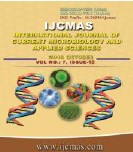


 National Academy of Agricultural Sciences (NAAS)
National Academy of Agricultural Sciences (NAAS)

|
PRINT ISSN : 2319-7692
Online ISSN : 2319-7706 Issues : 12 per year Publisher : Excellent Publishers Email : editorijcmas@gmail.com / submit@ijcmas.com Editor-in-chief: Dr.M.Prakash Index Copernicus ICV 2018: 95.39 NAAS RATING 2020: 5.38 |
In the field of plant pathology, exploitation of metal nanoparticles in bacterial disease management is a novel and needy approach. Green synthesis of nanoparticles is most prioritized because of their safe, eco-friendly nature and cost effectiveness. A total of 16 fluorescent pseudomonad isolates were obtained from different crop rhizosphere in various locations. The isolates were screened for zinc utilization capabilities. Among the 16 isolates, one isolate (FPGrChHi-6) showed maximum zone of zinc utilization (30.00 mm) with bacterial growth (12.00 mm). Molecular characterization of isolate revealed that, isolate FPGrChHi-6 belongs to Pseudomonas fluorescens. Further, zinc nanoparticles (ZnNPs) were synthesized by using P. fluorescens extract. The green synthesized ZnNPs were characterized using various instruments. The UV-vis spectrophotometer analysis showed the prominent peak at 360 nm, which indicated the synthesis of ZnNPs. The characterization through particle size analyzer and atomic force microscope found that, the mean diameter of ZnNPs was found to be 21.40 nm with spherical to irregular in shape. ZnNPs showed phytotoxicity symptoms on tomato seedlings at 1500 ppm concentration and onwards. ZnNPs showed excellent antibacterial activity against Xanthomonas oryzae pv. oryzae and Xanthomonas axonopodis pv. punicae. Among tested concentrations, maximum inhibition zones were noticed against Xap (21.76 mm) and Xoo (15.67 mm) at 1000 ppm and 1250 ppm concentrations respectively.
 |
 |
 |
 |
 |